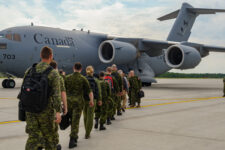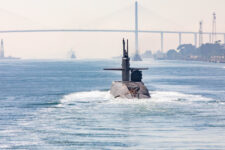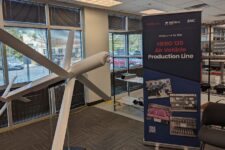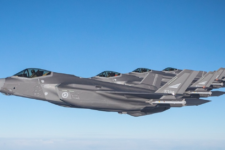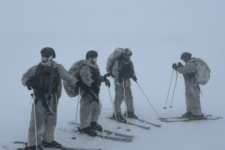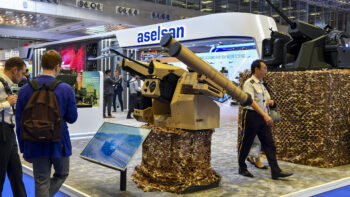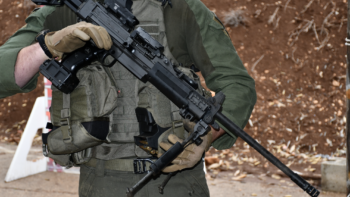AM General’s corporate ancestors built jeeps in World War II. The company designed and still builds the military’s iconic Humvee. But in the battle to build the Humvee’s replacement, the Joint Light Tactical Vehicle, AM General is ironically not the incumbent but the scrappy underdog.
[Follow these links to read more and see video about AM General’s competitors, Lockheed Martin and Oshkosh, and read about the JLTV competition overall].
Here’s AM General’s image problem: The Humvee is still iconic — but not in a good way. In the 1990s, after the victory of Desert Storm, the High Mobility Multi-Purpose Wheeled Vehicle (HMMWV, pronounced “Humvee”) became such a symbol of American military might that Arnold Schwarzenegger bought one to drive, jump-starting a fad. After 2003, however, the emblematic image of a Humvee became one of twisted wreckage, blown apart by a roadside bomb.
The military scrambled to uparmor its Humvees, layering on more and more protection until the chassis could take no more. At that point it switched to the much heavier, and much less maneuverable, Mine-Resistant Ambush-Protected (MRAP) trucks. But AM General does not make MRAPs.
The latest, lightest, most nimble version of the MRAP, the MRAP All-Terrain Vehicle (M-ATV), is the closest thing in current service to what the Army and Marine Corps want in the JLTV. So it’s the M-ATV’s maker, Oshkosh, that is the closest thing to an incumbent in the current competition.
Oshkosh, incidentally, is a major maker of both civilian and military trucks with over 13,000 employees. The third JLTV competitor, Lockheed Martin, has relatively little track record in ground vehicles but is the world’s largest defense company, employing a staggering 120,000 people worldwide. AM General’s workforce? “Approximately 2,000.“
So here’s AM General’s two-part challenge on JLTV: first, compete on equal terms with much larger, better-resourced firms; second, convince the military that their entry, the BRV-O (Blast-Resistant Vehicle – Offroad) builds on the best parts of their Humvee heritage where it can — especially automotive design — but departs from the past where it must — in protection.
“The base structure is different between the two systems,” AM General Vice President Chris Vanslager emphasized in an interview with Breaking Defense. “The JLTV has a different mission profile, different requirements.”
The Humvee was designed for Cold War battlefronts in Germany and Korea, where the US military expected a conventional clash with clear front lines. Heavy tanks and dug-in infantry would hold the line while light trucks like the Humvee would scurry around in the rear. At most, the Humvee needed to be protected against small-arms fire from enemy scouts. If there were any mines, they’d be the ones our own forces laid to stop the advancing Communists. Then came the guerrilla wars in Afghanistan and Iraq, where the main threat was the homemade landmines called IEDs — improvised explosive devices — exploding upwards from below.
“The threats initially were just the direct fire threats from 360 degrees around the vehicle and from the roof,” Vanslager said. “The threats evolved into a blast under the vehicle.”
The Humvee is designed like a conventional civilian car or truck, with armor added almost as an afterthought. The floor and seats are supported by the vehicle’s metal frame — which transmits the shock from a blast beneath the truck right through the chassis into the occupants.
Not so with JLTV. AM General — like its competitors — has designed their JLTV contender from the ground up, literally, to take a mine blast and survive. The crew are inside a kind of armored “capsule,” their seats suspended from the ceiling, with a “floating floor” between them and the blast. Every feature of these vehicles, not just the external armor but the internal structure itself, is designed to channel explosive energy away from the crew.
“Our vehicle as a system is designed to protect the occupants,” Vansleger said. “It doesn’t just start with the armor that is on the vehicle, it goes down inside all the way to the seats and the restraint systems.”
So on protection, AM General argues, their JLTV is on a par with the competitors. On automative performance, reliability, and ease of maintenance, they say, it’s got the edge — the upside of the 43-year heritage of the Humvee.
AM General has built “300,000 light tactical vehicles in this class size,” Vanslager said. “For the last 10 years we’ve invested over a $100 million dollars on new technology” — that’s $100 million of the company’s own money, not federal contract dollars — “on automative improvements, advanced automative technologies, as well as survivability.”
AM General, for example, builds the engine for their JLTV, out of their wholly owned subsidiary, General Engine Products. By contrast, even though Oshkosh is a major truck manufacturer, it doesn’t build its own engines: Its JLTV contender runs on a Duramax from General Motors. Lockheed’s JLTV has a Cummins engine and, for that matter, is largely built by BAE’s Seely, Texas plant (formerly Stewart & Stevenson), with Lockheed providing electronics and acting as the “integrator” of its teammates’ contributions. Outsourcing a component, even one as central as an engine, is not a disability in this age of multi-company teams, but the fact that AM General builds their engine in-house certainly sets them apart.
While AM General emphasizes their JLTV is an all-new design, they also reused proven Humvee components whever they could. The exact count depends on whether you consider a transmission, for example, to a single “part” or several, but Vanslegger says about 40 percent of the parts on their JLTV are ones already in the military supply system. And AM General’s 21 JLTV prototypes to be delivered to the government for testing are being built just outside South Bend, Ind. on the company’s existing Humvee production line.
“Don’t think it’s a disadvantage that we have this legacy of Humvee,” said Vanslager. “We’re the light tactical [vehicle] guys…. We’ve been doing it for fifty-plus years.”
Out of INF, Army deploys Typhon weapon to the Philippines
“This is a significant step in our partnership with the Philippines, our oldest treaty ally in the region,” said Brig. Gen. Bernard Harrington, commanding general of the 1st MDTF.









